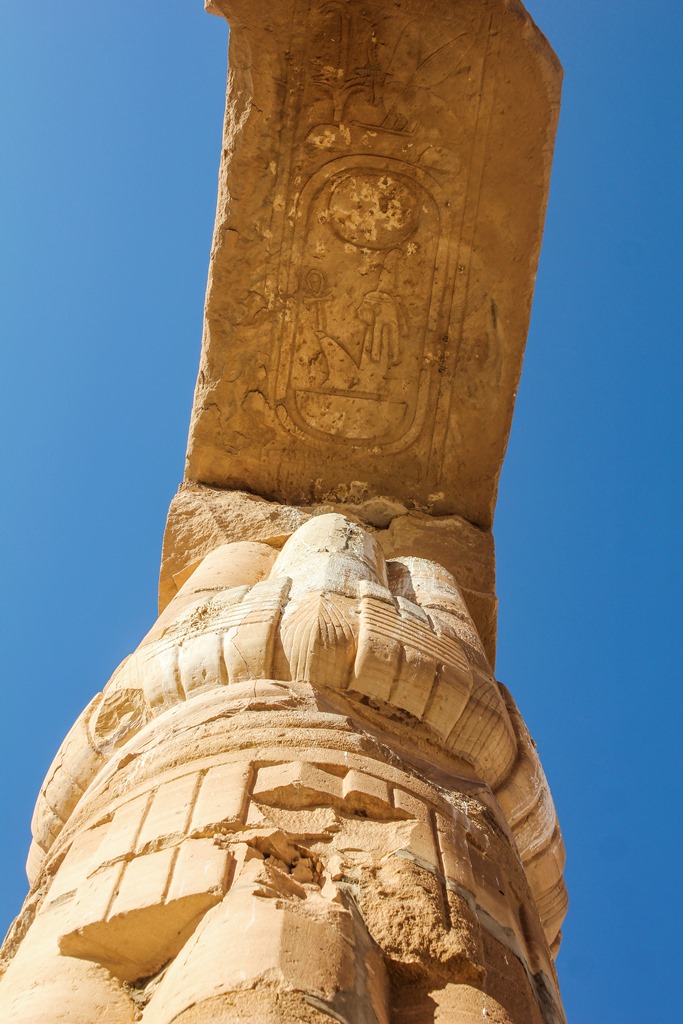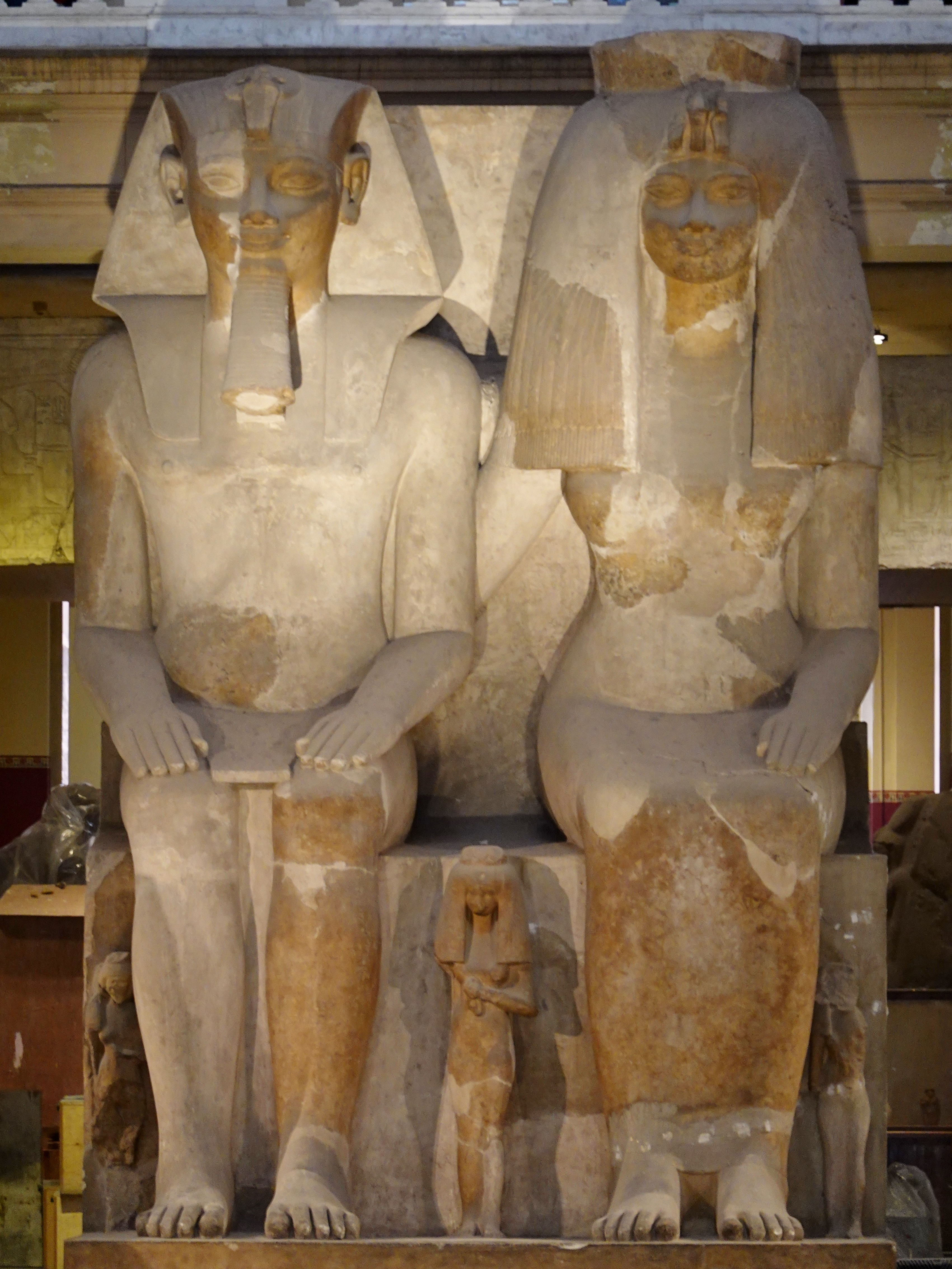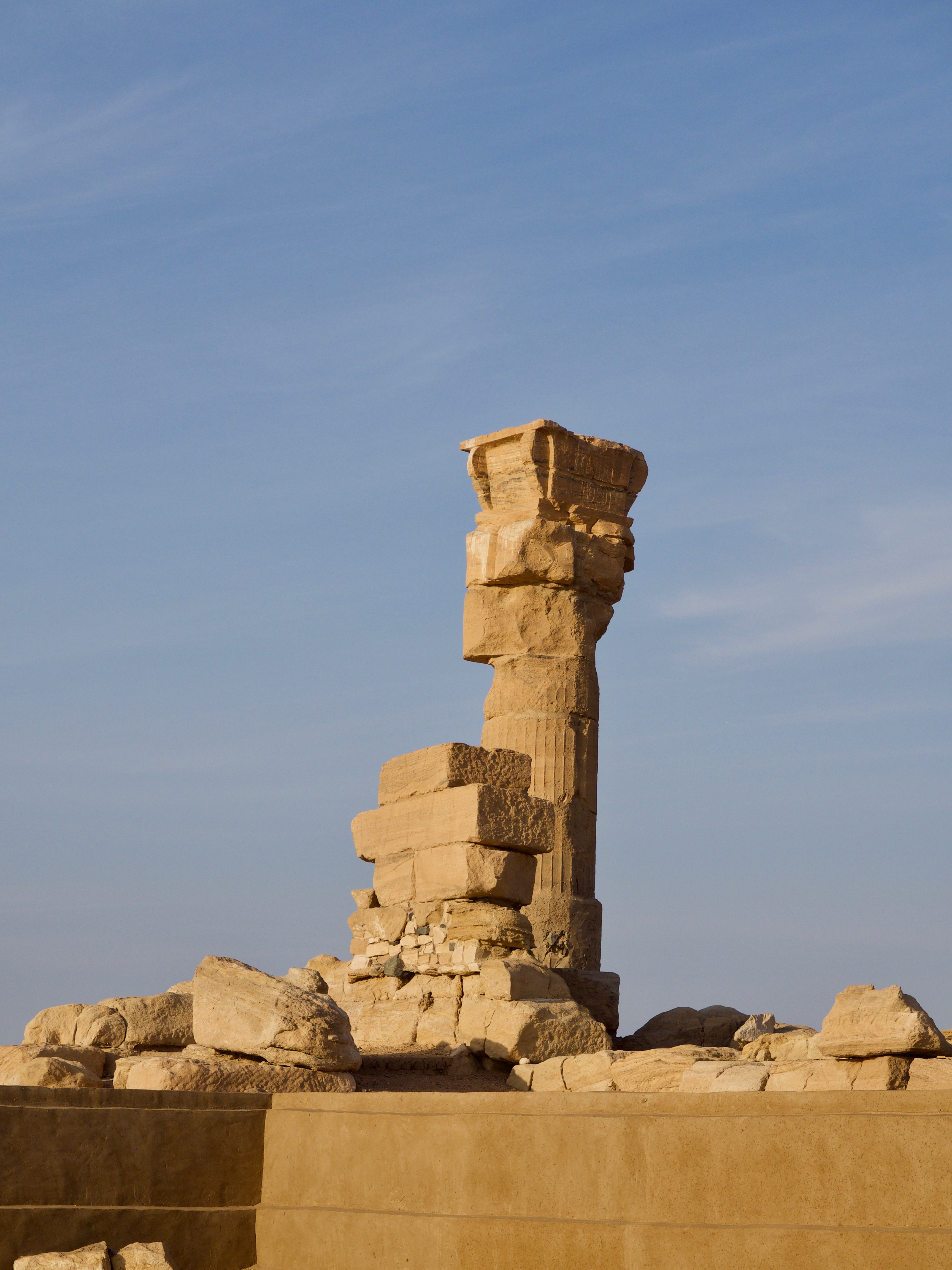|
Soleb2
Soleb is an ancient town in Nubia, in present-day Sudan. The site is located north of the third cataract of the Nile, on the western side of the Nile. It was discovered and described by Karl Richard Lepsius in 1844. Necropolis Soleb is also the location of a vast necropolis with small tomb chapels decorated with pyramids. The earliest royal tombs date to the 18th dynasty, whereas some belong to the Ramesside and Meroitic periods. Amarna Period During the Amarna Period (Mid 18th Dynasty), several pharaohs attended to Soleb, such as Amenhotep III, Akhenaten, Tutankhamun, and Ay. Amenhotep III A large temple made of sandstone was founded here by Amenhotep III. It is the southernmost temple currently known to have been built by this pharaoh. The temple was consecrated to the deity Amun Re and to the pharaoh depicted deified with ram-horns. The architect may have been Amenhotep, son of Hapu. At Sedeinga, a companion temple was built by Amenhotep III to Queen Tiye as a man ... [...More Info...] [...Related Items...] OR: [Wikipedia] [Google] [Baidu] |
Soleb2
Soleb is an ancient town in Nubia, in present-day Sudan. The site is located north of the third cataract of the Nile, on the western side of the Nile. It was discovered and described by Karl Richard Lepsius in 1844. Necropolis Soleb is also the location of a vast necropolis with small tomb chapels decorated with pyramids. The earliest royal tombs date to the 18th dynasty, whereas some belong to the Ramesside and Meroitic periods. Amarna Period During the Amarna Period (Mid 18th Dynasty), several pharaohs attended to Soleb, such as Amenhotep III, Akhenaten, Tutankhamun, and Ay. Amenhotep III A large temple made of sandstone was founded here by Amenhotep III. It is the southernmost temple currently known to have been built by this pharaoh. The temple was consecrated to the deity Amun Re and to the pharaoh depicted deified with ram-horns. The architect may have been Amenhotep, son of Hapu. At Sedeinga, a companion temple was built by Amenhotep III to Queen Tiye as a man ... [...More Info...] [...Related Items...] OR: [Wikipedia] [Google] [Baidu] |
Sudan
Sudan ( or ; ar, السودان, as-Sūdān, officially the Republic of the Sudan ( ar, جمهورية السودان, link=no, Jumhūriyyat as-Sūdān), is a country in Northeast Africa. It shares borders with the Central African Republic to the southwest, Chad to the west, Egypt to the north, Eritrea to the northeast, Ethiopia to the southeast, Libya to the northwest, South Sudan to the south and the Red Sea. It has a population of 45.70 million people as of 2022 and occupies 1,886,068 square kilometres (728,215 square miles), making it Africa's List of African countries by area, third-largest country by area, and the third-largest by area in the Arab League. It was the largest country by area in Africa and the Arab League until the 2011 South Sudanese independence referendum, secession of South Sudan in 2011, since which both titles have been held by Algeria. Its Capital city, capital is Khartoum and its most populated city is Omdurman (part of the metropolitan area of Khar ... [...More Info...] [...Related Items...] OR: [Wikipedia] [Google] [Baidu] |
Sandstone
Sandstone is a clastic sedimentary rock composed mainly of sand-sized (0.0625 to 2 mm) silicate grains. Sandstones comprise about 20–25% of all sedimentary rocks. Most sandstone is composed of quartz or feldspar (both silicates) because they are the most resistant minerals to weathering processes at the Earth's surface. Like uncemented sand, sandstone may be any color due to impurities within the minerals, but the most common colors are tan, brown, yellow, red, grey, pink, white, and black. Since sandstone beds often form highly visible cliffs and other topographic features, certain colors of sandstone have been strongly identified with certain regions. Rock formations that are primarily composed of sandstone usually allow the percolation of water and other fluids and are porous enough to store large quantities, making them valuable aquifers and petroleum reservoirs. Quartz-bearing sandstone can be changed into quartzite through metamorphism, usually related to ... [...More Info...] [...Related Items...] OR: [Wikipedia] [Google] [Baidu] |
Joann Fletcher
Joann Fletcher (born 30 August 1966) is an Egyptologist and an honorary visiting professor in the department of archaeology at the University of York. She has published a number of books and academic articles, including several on Cleopatra, and made numerous television and radio appearances. In 2003, she controversially claimed to have identified the mummy of Queen Nefertiti. Early life and education Fletcher was born on 30 August 1966 in Barnsley. She was educated at Barnsley College, a sixth-form and further education college in Barnsley. She studied ancient history and Egyptology at University College London, specializing in the Ptolemaic dynasty and Cleopatra, and also in ancient Egyptian hair, wigs, and forms of adornment. She graduated with a Bachelor of Arts (BA) degree in 1987. Her Doctor of Philosophy (PhD) degree completed in 1996 was undertaken at the University of Manchester, with the thesis on hair and wigs entitled "Ancient Egyptian Hair: a study in style, form, a ... [...More Info...] [...Related Items...] OR: [Wikipedia] [Google] [Baidu] |
Eric H
The given name Eric, Erich, Erikk, Erik, Erick, or Eirik is derived from the Old Norse name ''Eiríkr'' (or ''Eríkr'' in Old East Norse due to monophthongization). The first element, ''ei-'' may be derived from the older Proto-Norse language, Proto-Norse ''*wikt:Reconstruction:Proto-Germanic/ainaz, aina(z)'', meaning "one, alone, unique", ''as in the form'' ''Æ∆inrikr'' explicitly, but it could also be from ''*wikt:Reconstruction:Proto-Germanic/aiwaz, aiwa(z)'' "everlasting, eternity", as in the Gothic form ''Euric''. The second element ''-wikt:ríkr, ríkr'' stems either from Proto-Germanic language, Proto-Germanic ''*wikt:Reconstruction:Proto-Germanic/rīks, ríks'' "king, ruler" (cf. Gothic ''wikt:𐍂𐌴𐌹𐌺𐍃, reiks'') or the therefrom derived ''*wikt:Reconstruction:Proto-Germanic/rīkijaz, ríkijaz'' "kingly, powerful, rich, prince"; from the common Proto-Indo-European language, Proto-Indo-European root *wikt:Reconstruction:Proto-Indo-European/h₃rḗǵs, h� ... [...More Info...] [...Related Items...] OR: [Wikipedia] [Google] [Baidu] |
David O'Connor (Egyptologist)
David Bourke O'Connor (5 February 1938 – 1 October 2022) was an Australian-American Egyptologist who primarily worked in the fields of Ancient Egypt and Nubia. O'Connor is the Lila Acheson Wallace Professor Emeritus at New York University's Institute of Fine Art, the Curator Emeritus of the University of Pennsylvania's Egyptian Museum, and the director emeritus of the Abydos Archaeology expedition in Egypt. O'Connor is most well known for his work in the excavation of the ancient city of Abydos in Egypt since 1967. Early life Born in Sydney in 1938, O'Connor's interests in archaeology and ancient history originated when he was a child. His initial interest centred around the ancient civilization of Babylon. O'Connor built a replica of the city of Babylon out of bricks in a field adjacent to his home, and recreated the Fall of Babylon by setting the field alight during the height of the 1968-69 bushfires in New South Wales. Education O'Connor received a Bachelor of Arts ... [...More Info...] [...Related Items...] OR: [Wikipedia] [Google] [Baidu] |
Sekhmet
In Egyptian mythology, Sekhmet ( or Sachmis (), also spelled Sakhmet, Sekhet, Sakhet among other spellings, cop, Ⲥⲁⲭⲙⲓ, Sakhmi), is a warrior goddess as well as goddess of healing. She is depicted as a lioness. Sekhmet is a solar deity, sometimes called the daughter of Ra and often associated with the goddesses Hathor and Bastet. Roles Sekhmet was the daughter of the sun god, Ra, and was among the more important of the goddesses who acted as the vengeful manifestation of Ra's power, the Eye of Ra. Sekhmet was said to breathe fire, and the hot winds of the desert were likened to her breath. She was also believed to cause plagues (which were called as her servants or messengers) although she was also called upon to ward off disease. In a myth about the end of Ra's rule on the earth, Ra sends the goddess Hathor, in the form of Sekhmet, to destroy mortals who conspired against him. In the myth, Sekhmet's blood-lust was not quenched at the end of battle that led to ... [...More Info...] [...Related Items...] OR: [Wikipedia] [Google] [Baidu] |
Prudhoe Lions
The Prudhoe Lions, or Soleb Lions, are a pair of Ancient Egyptian red granite monumental sculptures dating from the 18th Dynasty, around 1370 BC. They are now presented in the British Museum. The lions originally stood as guardian figures at the Temple of Soleb in Nubia, which was built by the 18th Dynasty King Amenhotep III. Unsurprisingly for such magnificent statues, the lions carry many inscriptions which record their re-use by various rulers. The original inscriptions relate to the pharaoh Amenhotep III. The renewal of the temple by Tutankhamun is also recorded: "he who renewed the monument of (or 'for') his father, the King of Upper and Lower Egypt, Lord of the Two Lands, Nebmare, image of Re, Son of Re, Amenophis, Ruler of Thebes" Another inscription indicates that they were moved by Ay, Tutankhamun's successor. In the 3rd century BC, the lions were moved to Jebel Barkal, a city to the south of the country by Amanislo, a Kushite king of Meroë. Following tradition, Amanis ... [...More Info...] [...Related Items...] OR: [Wikipedia] [Google] [Baidu] |
Eye Of Ra
The Eye of Ra or Eye of Re is a being in ancient Egyptian mythology that functions as a feminine counterpart to the sun god Ra and a violent force that subdues his enemies. The eye is an extension of Ra's power, equated with the disk of the sun, but it often behaves as an independent goddess. This goddess can be equated with several particular deities, including Hathor, Sekhmet, Bastet, Raet-Tawy, and Mut. The eye goddess acts as mother, sibling, consort, and daughter of the sun god. She is his partner in the creative cycle in which he begets the renewed form of himself that is born at dawn. The eye's violent aspect defends Ra against the agents of disorder that threaten his rule. This dangerous aspect of the eye goddess is often represented by a lioness or by the uraeus, or cobra, a symbol of protection and royal authority. The Eye of Ra is similar to the Eye of Horus, which belongs to a different god, Horus, but represents many of the same concepts. The disastrous effects when t ... [...More Info...] [...Related Items...] OR: [Wikipedia] [Google] [Baidu] |
Queen Tiye
Tiye (c. 1398 BC – 1338 BC, also spelled Tye, Taia, Tiy and Tiyi) was the daughter of Yuya and Thuya. She became the Great Royal Wife of the Egyptian pharaoh Amenhotep III. She was the mother of Akhenaten and grandmother of Tutankhamun. In 2010, DNA analysis confirmed her as the mummy known as "The Elder Lady" found in the tomb of Amenhotep II (KV35) in 1898. Family and early life Tiye's father, Yuya, was a non-royal, wealthy landowner from the Upper Egyptian town of Akhmim, where he served as a priest and superintendent of oxen or commander of the chariotry. Tiye's mother, Thuya, was involved in many religious cults, as her different titles attested (''Singer of Hathor'', ''Chief of the Entertainers'' of both Amun and Min...), which suggests that she was a member of the royal family. Egyptologists have suggested that Tiye's father, Yuya, was of foreign origin due to the features of his mummy and the many different spellings of his name, which might imply it was a non-Egyp ... [...More Info...] [...Related Items...] OR: [Wikipedia] [Google] [Baidu] |
Sedeinga
The Sedeinga pyramids are a group of at least 80 small pyramids near Sedeinga, Sudan, built ca. 1 BCE. They were discovered between 2009 and 2012 and date to the time of the Kingdom of Kush, an ancient kingdom in Nubia. They range in size from about to wide. Location The Sedeinga pyramid site is located in northern Sudan on the west bank of the Nile River. It lies roughly 60 miles (100 km) north of the Nile's third cataract, and northwest of Meroë, the Meroitic period capital of the Kingdom of Kush, where similar pyramids have been found. Isolated from the greater part of Kush, Sedeinga is found alone in the desert along an ancient trade route. This route connected the Kingdom of Kush directly with Middle Egypt, suggesting that Sedeinga may have been a trade settlement. Located not far from the Egyptian border, Sedeinga would have had first access to the goods brought by Egyptian traders, which might explain the origin of the wealth demonstrated in the burial pyramids.Powell, ... [...More Info...] [...Related Items...] OR: [Wikipedia] [Google] [Baidu] |


Saunders_Quarry-1.jpg)
.jpg)


